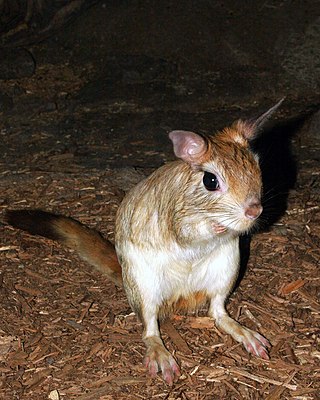
The Pedetidae are a family of rodents. The two living species, the springhares, are distributed throughout much of southern Africa and also around Kenya, Tanzania, and Uganda. Fossils have been found as far north as Turkey. Together with the anomalures and zenkerella, Pedetidae forms the suborder Anomaluromorpha. The fossil genus Parapedetes is also related.
Vinckeia is a subgenus of the genus Plasmodium — all of which are parasitic alveolates. The subgenus Vinckeia was created by Cyril Garnham in 1964 to accommodate the mammalian parasites other than those infecting the primates.
The arid thicket rat is a species of rodent in the family Muridae. It is found only in Sudan. Its natural habitat is subtropical or tropical dry shrubland. This species is currently listed on the "Nearly Threatened" list in its ranking of endangerment. Offspring of this species are commonly referred to as "kittens" or "pups". The female is referred to as a "doe", while the male is referred to as a "buck". These creatures commonly roam in groups, called a "horde", "pack", or "storm".
Bunting's thicket rat is a species of rodent in the family Muridae. It is found in Ivory Coast, Guinea, Liberia, Senegal, and Sierra Leone. Its natural habitats are subtropical or tropical moist lowland forests and subtropical or tropical moist shrubland.
The gray-headed thicket rat is a species of rodent in the family Muridae. It is found in Kenya and Somalia. Its natural habitat is subtropical or tropical dry shrubland.
The Mozambique thicket rat is an African species of rodent in the mouse family, Muridae. It is found in Mozambique, South Africa, and Zimbabwe. Its natural habitat is subtropical or tropical dry forests.

The woodland thicket rat is a species of rodent in the family Muridae. It is found in Angola, Burundi, Democratic Republic of the Congo, Kenya, Malawi, Mozambique, Rwanda, South Africa, South Sudan, Eswatini, Tanzania, Zambia, and Zimbabwe. Its natural habitats are subtropical or tropical dry forest, subtropical or tropical moist lowland forest, subtropical or tropical dry shrubland, subtropical or tropical moist shrubland, subtropical or tropical high-altitude shrubland, subtropical or tropical dry lowland grassland, arable land, pastureland, and urban areas.
The forest thicket rat is a species of rodent in the family Muridae. It is found in Burundi, Democratic Republic of the Congo, and Uganda. Its natural habitat is subtropical or tropical moist montane forests.
The giant thicket rat is a species of rodent in the family Muridae which is restricted to a small area of Kenya.
The Ruwenzori thicket rat is a species of rodent in the family Muridae. It is found in Kenya, Malawi, South Sudan, Tanzania, Uganda, and Zambia. Its natural habitats are subtropical or tropical moist montane forests and subtropical or tropical high-altitude shrubland. It is threatened by habitat loss.
Macmillan's thicket rat is a species of rodent in the family Muridae. It is found in Central African Republic, Democratic Republic of the Congo, Ethiopia, Kenya, South Sudan, Tanzania, and Uganda. Its natural habitats are subtropical or tropical moist lowland forest, subtropical or tropical swamps, subtropical or tropical seasonally wet or flooded lowland grassland, shrub-dominated wetlands, and urban areas.
The Ethiopian thicket rat is a species of rodent in the family Muridae. It is found only in Ethiopia. Its natural habitat is subtropical or tropical dry shrubland. It is threatened by habitat loss.
The shining thicket rat is a species of rodent in the family Muridae.
The eastern rainforest grammomys, also known as the eastern rainforest thicket rat, is a species of rodent from the family Muridae.
The short-snouted thicket rat is a species of rodent endemic to Kenya.

Arvicanthini is a tribe of muroid rodents in the subfamily Murinae. Almost all recent species in this tribe are or were found in Africa aside from one species, the Indian bush rat, which is found in South Asia and Iran. However, some fossil Golunda species from India and the genus Parapelomys are thought to have also occurred outside Africa, and one species in the fossil genus Saidomys may have also occurred in Afghanistan.
The Selous thicket rat is a species of rodent endemic to Tanzania.



